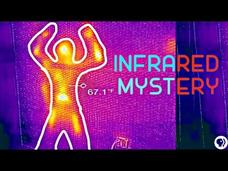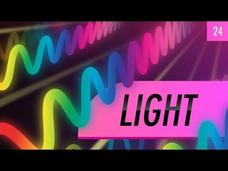Curated Video
Night Vision Techiques And The Use Of The Metascope And Starlight Scope
Story 3 Ref 111 TF 4121 col sound
Night Vision techiques and the Use of the Metascope and Starlight scope 22 February 1964
SD version available in \\Source_Clips\FB Tapes
...
Physics Girl
The Ultraviolet Catastrophe
What do scientists do when their observations don't match the theory? An interesting video introduces the ultraviolet catastrophe as part of a larger series covering physics concepts. Starting with ultraviolet light and ending with...
TED-Ed
How Light Technology Is Changing Medicine
Medicine has gone high tech. But how do the new, less invasive diagnostic tools work? An engaging short video sheds light on how integrated photonics is revolutionizing the medical sensor industry.
Veritasium
Science of Laser Hair Removal in SLOW MOTION
Lasers attack hair cells from the outside in. Young scholars observe a laser hair treatment in slow motion. They watch as the pulses of the laser destroy the external hair. The Veritasium instructor then describes the process happening...
PBS
The Electromagnetic Spectrum
What can the electromagnetic spectrum tell us about the sun? As it turns out, quite a bit! See the sun in a whole new light with a video from NOVA's Sun Lab unit. The narrator describes the electromagnetic spectrum in terms of visible...
Physics Girl
Solving Crimes with Infrared?
Do you have a camera that can see through walls? Physics Girl and Nickipedia team up to explain infrared cameras as part of a larger series of videos. It offers a demonstration of the technology as well as an explanation of the science.
American Chemical Society
Four Science Secrets About Money
Strange fact—most dollar bills have a trace of cocaine! Chemists can tell us many interesting facts about money. Science makes counterfeiting an almost impossible process. An installment of the ACS Reaction series explains these...
THNKR
Bill Nye Searches For Water On Jupiter
How can researchers measure the amount of water on Jupiter? Through a thought-provoking THNKR "Why with Nye!" video, young space scientists search for the universal solvent on a distant planet. Topics include how scientists use visible...
Crash Course
Deep Time
Are our universe's days numbered? Yes and no, depending on how you look at it. Travel as far into the future as possible in a video describing the five ages of the universe. The narrator begins the tale in current days, which are the...
Crash Course
A Brief History of the Universe
No one was actually there to see the birth of the universe, but years of collaboration between physicists and mathematicians allow us to glimpse all but a fraction of a second of it. A narrated journey shows the phase changes...
Crash Course
Galaxies, Part 2
Worlds within worlds! Journey to galaxies near and far with a thought-provoking video. Young astronomers learn how scientists detected very distant galaxies using their electromagnetic signatures far outside the visible range. Other...
Crash Course
Nebulae
A star is born! Introduce young astronomers to the characteristics of nebulae in a narrated video. Discover what they are made of, why some reflect light and others glow on their own, and the locations of several notable nebulae. The...
Crash Course
Brown Dwarfs
Not quite a star, not quite a planet ... what are brown dwarfs? Young astronomers learn the peculiarities of these heavenly bodies through a short video. The narrator explains the characteristics of brown dwarfs and the different types....
Crash Course
Light
All this talk about seeing the light... but, what is it, and how do we see it? Science students learn the basics of the nature of light in a narrated video that discusses concepts such as how light behaves, the electromagnetic...
MinutePhysics
Why Is It Dark at Night?
Don't keep your physics class in the dark about night—introduce them to the concept with a short animated video! The narrator discusses how the Big Bang set our universe into an ever-expanding motion where the stars we observe now appear...
MinutePhysics
The Origin of Quantum Mechanics (feat. Neil Turok)
How do you get the most light out of a light bulb? That's the task Max Planck took on, and it turned out to be rather...enlightening! The illustrated video introduces physics scholars to Planck's plight, which ultimately changed our...
Fuse School
What Is The Natural Greenhouse Effect?
The Greenhouse Effect is a big part of why Earth is able to sustain life. But, how much is too much? In part two of an eight-part series about the carbon cycle, environmental scholars learn how the natural Greenhouse Effect keeps us warm...
SciShow
9 Weird Ways Animals See the World
Chiton are mollusks that have no face, but have many eyes made from a component found in limestone. Here is a video that introduces nine ways animals see the world, including through rock eyes like chiton. Viewers learn about a vision...
SciShow
The Most Sophisticated Mirror in the Universe
The most sophisticated mirror in the universe is blurry at room temperature. An informative video discusses the five challenges the mirror had to overcome. It addresses each individually and how it was solved. Then it explains the future...
TED-Ed
How Quantum Mechanics Explains Global Warming
What do quantum mechanics and global warming have to do with each other? More than you might think. Surprisingly, this video explains how it's not the energy emitted from the sun that causes the problem, but how the infrared radiation...
Curated OER
Infrared Light
Infrared light is described as a light frequency we are unable to see. This clip shows how infrared works to send an "invisible" signal to turn on the TV. This clip doesn't explain why we can't see infrared but it does raise some...
PBS
Pbs Learning Media: Infrared: More Than Your Eyes Can See
In this video segment adapted from NASA, astronomer Michelle Thaller introduces the world of infrared light and demonstrates how infrared cameras allow us to see more than what the naked eye can perceive. [5:42]
California Institute of Technology
Infrared: More Than Your Eyes Can See
Infrared light may not be visible to the naked eye, but when seen through an infrared camera it can tell a great deal about the subject it's viewing. Learn about visible light and infrared rays in this short video by Dr. Michelle Thaller.






















